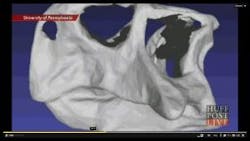3D images of dinosaur skulls show that three species are actually one
An imaging analysis performed by researchers at the University of Pennsylvania has revealed that multiple skulls of a single species of dinosaurs have been mislabeled for years as three distinct species.
Found in fossilized ashes of the Lujiatun beds of northeast China’s Yixian Formation, Psittacosaurus dinosaur skulls were originally classified into three distinct species: Psittacosaurus lujiatunensis, P. major or Hongshanosaurus houi. The researchers first conducted a traditional study in which they examined every skull that had been classified as one of those three species for a variety of characteristics that had been identified in previous studies.
Using a hand-held stylus that captures a point in space relative to a transmitter, the researchers then pinpointed 56 “landmark” spots on each dinosaur skull and compared the relative position of those marks between specimens. From there, the team performed a secondary analysis of the skulls using a technique called 3D geometric morphometrics, which is not dissimilar to a CT scan, in which hand-held laser-emitting scanners are used to generate 3D images of each specimen, which also allowed them to collect landmark data.
By creating 3D models of the Psittacosaurus skulls, the scientists were able to determine that the differences among the fossil remains that led scientists to label them as distinct species arose from how the dinosaurs were buried and compressed, or perhaps crushed, according to a press release on the study. In addition, based on the findings, the researchers propose that all three species were in fact one, and could be considered members of the species P. lujiatunensis.
"Hopefully this will open up the paleontological community to using three-dimensional geometrics morphometrics in a variety of ways," said Brandon Hedrick, a doctoral student in the department of earth and environmental science, and co-leader of the study. "This technique has limitless applications to understanding dinosaurs."
View the press release.
Also check out:
How 3D visualization software could be used to help treat injured soldiers
Five interesting applications of 3D scanning
Share your vision-related news by contacting James Carroll, Senior Web Editor, Vision Systems Design
To receive news like this in your inbox, click here.
Join our LinkedIn group | Like us on Facebook | Follow us on Twitter | Check us out on Google +
About the Author

James Carroll
Former VSD Editor James Carroll joined the team 2013. Carroll covered machine vision and imaging from numerous angles, including application stories, industry news, market updates, and new products. In addition to writing and editing articles, Carroll managed the Innovators Awards program and webcasts.
